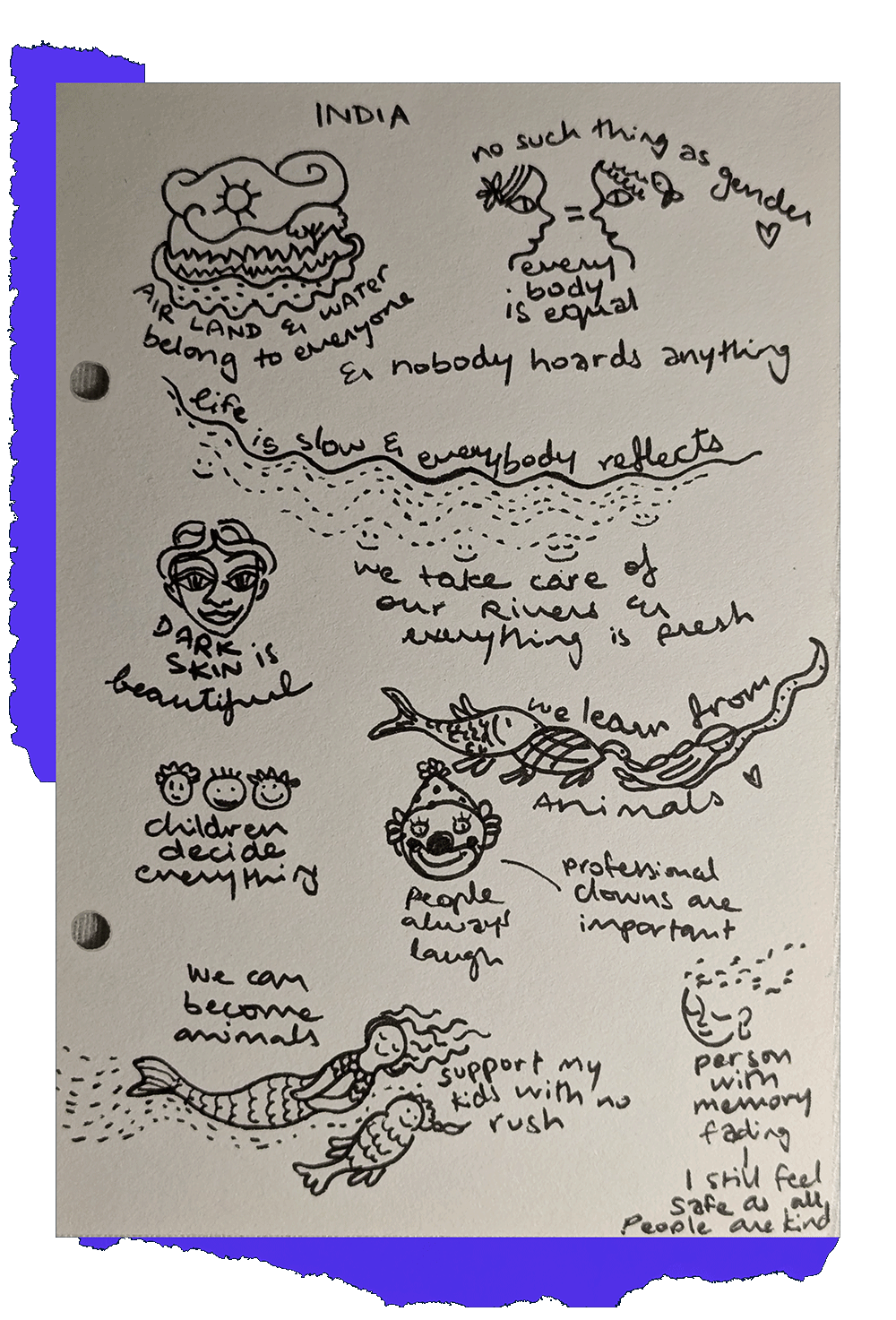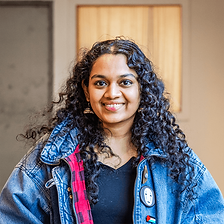Girls’ Dreaming and Worldbuilding
There is a Kannada proverb that I have heard all through my childhood: “ಹಾಸಿಗೆ ಇದ್ದಷ್ಟು ಕಾಲು ಚಾಚು.” Loosely translated, “haasige iddashtu kaalu chaachu” means to stretch your legs as far as your bed allows. Often used as an innocent word of caution, it warns us against living beyond one’s means, overreaching, overstepping. What fascinates me, however, is the imagery it conjures—of a bed that grows tinier and tinier, for a person struggling to sleep, tossing and turning, and even struggling to dream.
Perhaps no single group is offered a smaller bed to dream in, both literally and figuratively, than girls. Girls’ hopes and their dreams for the future are often co-opted, shrunk, erased, and ignored. Across the world, girls are told to dream smaller, take up less space, and fit into the mold that reality permits them.
Through this residency with Our Collective Practice, I sought to do the opposite. The residency offered me an invaluable opportunity to enlarge girls’ dreams to co-create a work that, in both substance and form, takes up the space that girls deserve. Space, that their imaginations deserve. Inviting girls to explore their creativity, imagination and dreams through games and play, this project envisions a possibility of a world with an unending bed that eventually flows out into a world where these dreams are a reality. A bed stretching so far that one’s legs—and dreams—stretch and flow out into the world, almost asserting in unison, “kaaliddashtu haasige chaachu”. “Stretch your bed as far as your legs reach.”
The Seed of the Residency
I crossed paths with Jody and Lau from Our Collective Practice during my masters program at NYU Gallatin. I had been creating a personalized study program exploring how stories and narratives shape our futures. At the heart of my exploration was, and continues to be the question, “What if our world was built on girls’ dreams for the future?” This question is artistically motivated, yes—but it is also deeply political.
Everything we know today as ‘reality’—clothes, flags, money, traffic rules, good manners, religions—is the product of someone’s imagination, often someone with systemic power. And this reality no longer works for most of us. We need to rebuild our world anew, and my masters thesis sought to find the first step. In unearthing this new world, I looked to unearth new values, new ideas of success, new aspirations. Ultimately, I looked to discover new narratives for building futures. Luckily for me, Our Collective Practice was exploring the same!
A near-final draft of my full thesis is linked here, and stay tuned for the update.




NOTES FROM NASCENT STAGES


Why Dreams?
Girls continue to dream, even when the world makes no space for it. Even when statistics pile up like bricks—early marriage, interrupted schooling, sexual violence—girls continue to imagine futures otherwise. Not despite these conditions, but within and against them. For most girls around the world, to dream is to resist.
Our Collective Practice’s monumental archive—Stories of Girls’ Resistance, is a treasure trove of knowledge and wisdom that I found to be the inspiration for my project. In Guyana, a girl says, “I’d like my daughter to grow up in a world where she feels safe and respected.” In Afghanistan, a girl dreams of a world “free of all kinds of subjugation.”
Dreams like these are rarely counted as data, or given space in strategy decks. But they exist. In vocalising them, girls resist. And they demand attention—not as background sentiment, but as world-shaping material.
SO THE QUESTION IS NOT WHETHER GIRLS DREAM. IT'S WHETHER WE'RE LISTENING.
The Dreaming & Worldbuilding Game
When I had started thinking about ways to truly converse with girls—with their dreams, it always worried me that the term “dream” would be perceived as a goal or an ambition dictated by the society they inhabit. With the markers of success in society often being distant or rooted in capitalist ideas of “making it”, perhaps such a direct question might lead to answers like “I dream of a world where I am a billionaire”, or “I dream of ruling the world!”
These are all understandable dreams in our current world, but still rooted in its systemically unequal structure. Instead, I wondered what girls might dream of if they could unmake our world entirely—completely reimagine it, its structure, foundation, skin and bone. So, I wondered if the usual means of interaction—often panels, interviews, or surveys—would offer any insight into radically new possibilities. This would need girls to be completely free to play, dance, and frolic in their imaginations.
BE UNTETHERED TO ANYTHING “REAL” OR “POSSIBLE”. AND THE ANSWER EMERGED: GAMES.
AT THE HEART OF THIS PROJECT IS A PARTICIPATORY TOOL: THE DREAMING & WORLDBUILDING GAME.
Through the radical act of uninhibited play, it provides an imaginative playground for girls—and everyone—to envision and build the worlds they want to live in.

The Films: Windows to Future Worlds
The girls’ new worlds—impossible, beautiful, broken and mended—became the seeds for a series of three experimental films. Each film is a fictional world, but rooted in real dreams. They weave together pieces of what girls shared during the game: visions of freedom, of absurdity, of unrecognizable joy.
In all the gameplay sessions, we noticed how often futures were imagined through the wreckage of the past. The theme of regeneration ran strongly throughout. Hence, I felt the materials used in the film would need to reflect this. Instead of using digital animation or comics to tell the stories, I decided that scraps of fabric coming together to create these new worlds would best symbolise these girls’ values. Moreover, as the entire artwork is about “building new worlds”, I decided to use my hands in the frame to shape and move the pieces of fabric to tell the story. This offered another way of depicting that worldbuilding is an intentional act which is no way passive in nature.

The Installation: Bridging Imagination and Reality
For the final public exhibit, I wanted to transport the audience into an alternative reality, freeing them from the constraints of the everyday. This led to me creating a space where the audience could peer into these fantastical worlds—the films ceased to be mere films, but became portals instead.
I MADE WINDOWS OUT OF SCREENS, AS A GENTLE NUDGE TO THE AUDIENCE TO LOOK OUTWARD. THESE NEW WORLDS WERE ALIVE AND BREATHING.
The films were held together by a dreamy, flowing, unending bed—as though they had emerged from the sheets and made their way outside. Throughout the artistic process where I centered these girls’ voices and dreams, I remained open to an organic flow of my own lived experiences shaping my girlhood. This took me back to the Kannada proverb that I have heard all through my childhood: “ಹಾಸಿಗೆ ಇದ್ದ ಷ್ಟು ಕಾಲು ಚಾಚು. ” “Stretch your legs as far as your bed allows.” I wondered how it might be to turn this proverb on its head.



INSTEAD OF FITTING ONE'S DREAMS IN A BED, WHAT IF THE BED MADE SPACE FOR ALL OUR DREAMS INSTEAD?
Almost with a sense of urgency, the bed leaps off the ground, its sheets reaching far and wide. The fabric’s dreamlike hand-painted patterns flow like watercolour, like dreams that travel and flow with a mix of chance and intention. From the fabric-collaged pillowcase emerge tiny scraps of cloth that burst from the pillowcase and into the “windows” outside. I collected these scraps of fabric from a multitude of places, just like these dreams. Feminists across the world have donated some scraps, some scraps have been saved from reaching landfills and the ocean thanks to fabric recycling centers in Brooklyn and Queens, and some have traveled halfway across the world from the streets of Bengaluru, which I collected with my mother from various tailors’ discard piles.
THE ELDERLY GENTLEMAN PICTURED HERE SPENT A CONSIDERABLE AMOUNT OF TIME ENGAGING WITH EACH FILM EXPRESSED HOW THE DREAMSCAPE INSTALLATION FILLED HIM WITH HOPE FOR THE FUTURE.
"I eagerly anticipate my six-month-old granddaughter growing up and envisioning her own world"




IN ADDITION TO THE INSTALLATION, I ENVISIONED A WORK WHERE THE AUDIENCE ACTIVELY CONTRIBUTES THEIR OWN DREAMS IN ESSENCE COMPLETING THE PIECE.
This led to two days of participatory programming, where I facilitated sessions where we held space for the public to play the game, create their own fabric collages, and share their dreams with each other.
The installation was exhibited at GG & POP Institute in New York City from 9-14 March, 2025, as part of a group show titled “Building New Worlds”, with art from four artists including myself, all of us supported by Our Collective Practice. For this and more, I am so deeply grateful.

“Si se apoyaran los sueños de las niñas y jóvenes feministas, el mundo sería un lugar más amable y pacífico, con menos guerras o ninguna, un lugar donde ninguna persona moriría de hambre y ni viviría en la calle. Tal vez sea una ilusión, tal vez el patriarcado aún se las arreglaría de algún modo para manifestarse en este mundo, pero creo que tendríamos más herramientas, recursos y educación emocional para hacerle frente.”
Carolina Vozian es escritora, trabajadora cultural, facilitadora, feminista y activista cuir(queer). Imparte talleres de escritura creativa, organiza actos culturales y políticos y ha publicado su primera novela y otros textos en volúmenes colectivos. Junto con Andy Andreea, es comisaria de la plataforma de arte especulativo radical lumiposibile.ro. Le gusta sentarse junto a las olas, los ríos, los abetos y los sauces. Nació y creció en la República de Moldavia y actualmente vive en Bucarest (Rumanía) con sus gatos.










